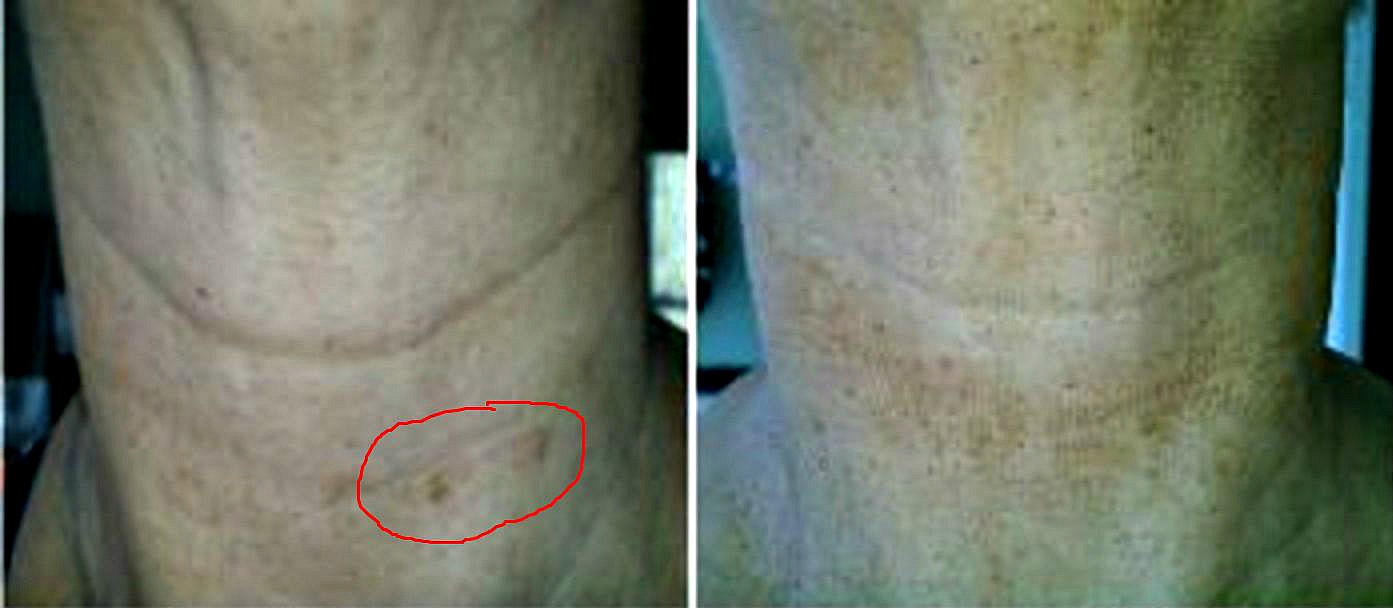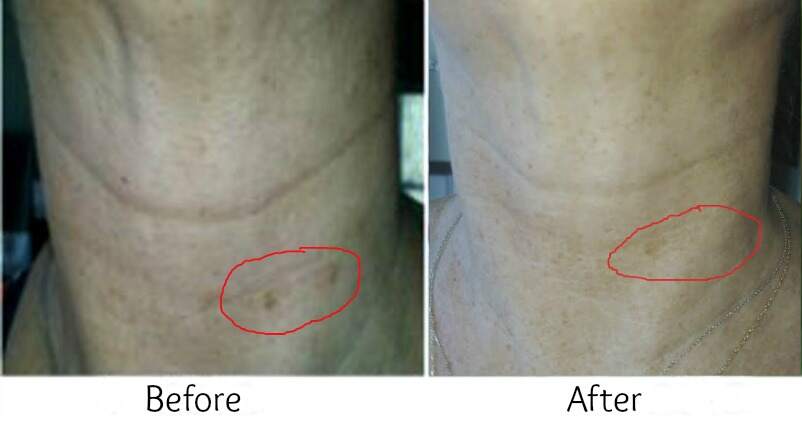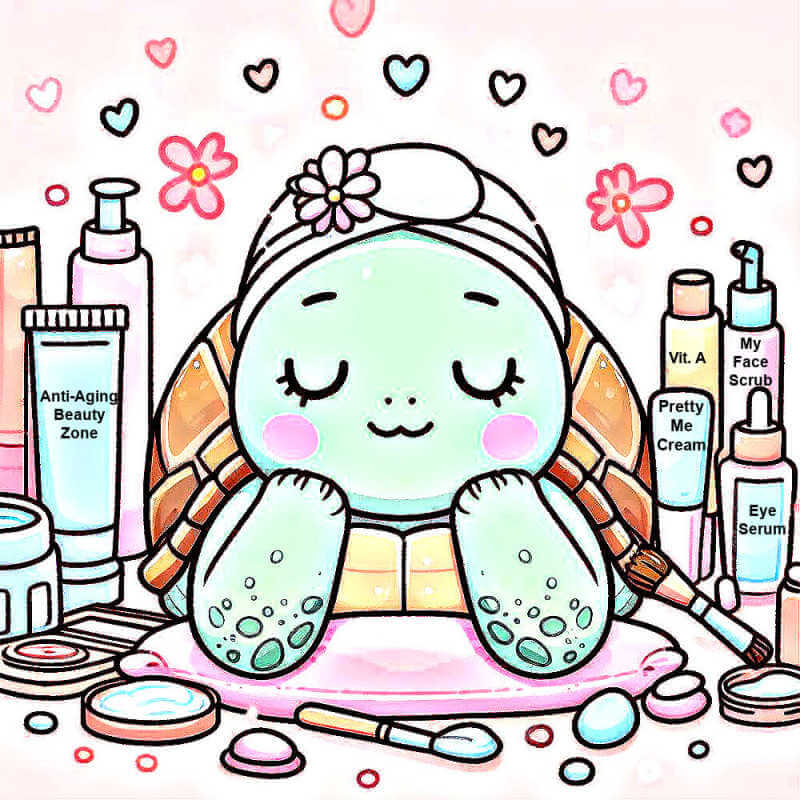As an Amazon Associate, I earn from qualifying purchases and other affiliate links. I only recommend products I’ve tried or researched.
- Home
- Skincare Guide
- Brighten
- Sun Spots
Sun Spots on Your Skin? Easy At-Home Tips That Work
by: Linda Robison / Facial Fitness Specialist
It's possible to lighten age spots with inexpensive treatments and preventive measures like sunscreen.
Yes, you can fade sun spots on your face at home with simple, consistent care.
If you’re noticing more sun spots or dark patches on your face, neck, or hands, you’re not alone. I’ve had the same stubborn spots show up in every photo—especially the one on my neck. It’s frustrating, but it’s also fixable with the right routine.
In this guide, I walk you through the steps that actually helped fade mine: daily vitamin C, gentle exfoliation, smart at-home peels, and sunscreen you’ll genuinely use. Nothing extreme. Just steady, doable habits.
I am living proof that this works. (I share my before-and-after photos a little further down.)

How to fade sun spots: the quick answer
Most sun spots can be lightened at home using three things:
- a daily vitamin C product
- gentle, regular exfoliation
- and consistent sun protection
This combination helps break up excess pigment, encourages brighter skin to come forward, and prevents new spots from forming. It’s not overnight—but it works.
If a spot looks very dark, raised, irregular, or is changing, get it checked by a dermatologist before treating it.
What sun spots actually are
Sun spots (also called age spots or solar lentigines) are flat brown patches that show up after years of UV exposure. They’re harmless but can make the skin look uneven or older than it is.
Good news: they respond well to steady at-home care. The goal is to gently lighten the pigment you already see while stopping new spots from forming. I talk more about overall skin brightening on my main brightening page.
If you ever notice a spot that looks unusual—very dark, irregular edges, itchy, bleeding, or just “not like the others”—see a dermatologist. It’s always best to rule things out first.
How to fade sun spots: what actually works
1. Topicals that target discoloration
This is my first line of defense. It brightens dull skin, supports collagen, and gradually lightens sun spots. I prefer fresh vitamin C—either serum or powder mixed into my moisturizer each morning.
This helps even out tone, calm redness, and support the skin barrier. It pairs well with vitamin C for most people and keeps skin steady while the brighter actives do their job.
Other brightening ingredients:
Gentle retinoids, alpha arbutin, and AHAs like lactic or glycolic acid can help fade discoloration over time. None of these erase spots overnight—but they nudge your skin in the right direction when used consistently.
2. At-home peels + exfoliation
At-home peels:
These help dissolve the glue between dead, pigmented skin cells so fresher skin can come forward. Some of my best results came from careful, once-a-week glycolic /lactic acid peels.
Scrubs:
Scrubs don’t remove sun spots, but they help clear away buildup once peels or actives loosen those old cells. My sugar scrubs are gentle enough for most over-40 skin types.
Note: don’t combine strong peels, retinoids, and scrubs on the same night.
3. Professional treatments (and what I learned)
I’ve tried in-office lasers for a large spot on my cheek. The spot did fade, but without supporting it with vitamin C, sunscreen, and gentle exfoliation, it slowly returned.
Lasers, deeper peels, and cryotherapy can help—but only if you keep up with your home routine. I learned the hard way: I tried cryotherapy but after a few months the spot came back.
What actually made the biggest difference for me
I’ve tried just about everything over the years — from drugstore brighteners to medical-grade peels. What surprised me most was that the real improvement didn’t come from one “big” treatment. It came from doing a few small things consistently.
Here’s the exact routine that finally made my sun spots fade enough that I felt comfortable taking close-up photos again.
My simple daily routine for fading sun spots
Morning
- Vitamin C: I use this every single morning, no exceptions. It’s the one product that gives me the most predictable brightening. When I skip it, my skin looks dull within a week.
- Moisturizer + sunscreen: This was the step I resisted for years, and I paid for it. If you’re brightening spots but not protecting your skin, the pigment will keep coming back. I now use a sunscreen that feels like a moisturizer, not a chore — that made all the difference.
Evening
- Gentle exfoliation (2–3 nights a week): I rotate between sugar scrubs and a mild lactic or glycolic product. Nothing strong. I’ve learned the hard way that when you overdo exfoliation, those dark spots look worse, not better.
- Retinoid or retinol serum (1–3 nights): This helps turn over pigmented skin cells faster and supports collagen. I keep it simple and adjust the frequency based on how my skin feels.
- Moisturizer: I always finish with something soothing. Brightening routines should never leave the skin feeling tight, itchy, or overly “worked.”
Weekly extras that helped my spots lighten faster
Regular exfoliation is a must to help sweep away the discolored skin spot. And help you see results faster.
1. A glycolic peel once a week
I used a 10–20% peel at home. I started slow — about five minutes — and gradually worked up. The goal isn’t to peel; it’s to loosen old, pigmented cells. See at-home chemical peel options.
2. Take it slow
If something looked red or sensitive, I backed off. Irritated skin almost always darkens or blotches more.
3. Taking progress photos
This helped me stay consistent. You don’t notice small changes in the mirror, but photos make it obvious.
My personal before-and-after experience
The biggest surprise That spot had been on my neck for years and barely budged with creams alone. It wasn’t until I added:
- consistent vitamin C serum
- gentle weekly exfoliation & monthly peels
- and daily sunscreen
…that it finally started to soften around the edges.

Several months later, not only is the spot almost gone, but my skin looks MUCH better, smoother

Realistic expectations
Most sun spots lighten gradually. The deeper ones may soften but not disappear fully — and that’s normal. What you can expect with steady care:
- brighter, more even skin
- spots that look softer and less sharp
- makeup that goes on easier
- a more uniform tone in photos
- less new pigment forming
This is slow and steady skincare. But it works.
I’m living proof of that.
If nothing seems to be working
Some sun spots are simply deeper. I learned this with the darker patch on my cheek — it barely moved until I supported it with a steady routine and a gentle peel.
Here’s what usually helps when progress stalls:
1. Simplify your routine
Too many products create irritation, and irritation often makes pigment worse. Pull back to the basics: vitamin C, gentle exfoliation, moisturizer, sunscreen.
2. Switch from scrubs to mild acids
Very stubborn spots sometimes respond better to a consistent AHA (like glycolic or lactic acid) than to physical scrubs.
3. Add a weekly peel
A controlled, mild peel can jump-start progress without damaging the skin.
4. Look at your sunscreen routine
This was a turning point for me. Brightening just doesn’t stick if UV exposure keeps refilling the pigment. Make sure your sunscreen has a high PA++++ rating.
5. Check with a dermatologist
If a spot looks unusual or is actively changing, always get it looked at. And if you want a stronger option, they can recommend lasers, cryotherapy, or stronger peels that work well with an at-home routine.
Takeaway: the realistic, steady path to brighter skin
The truth is, fading sun spots isn’t dramatic or complicated. It’s a handful of simple steps that work when you stick with them. I’ve lived through the frustration of watching a spot darken, fade, darken again, and finally lighten for good.
What made the difference wasn’t one special product.
It was consistency — vitamin C, gentle exfoliation, and sunscreen. Small steps, repeated.
If you stay steady, your skin will respond.
And when it does, you’ll notice a softer, brighter look in the mirror long before anyone else does.
next: vitamin c after Dermaplaning
FAQ: Sun spots on skin
Q: How long does it take to fade sun spots?
Q: How long does it take to fade sun spots?
A: Most people see steady improvement in 6–12 weeks with consistent care. Deeper spots can take longer. .
Q: What lightens sun spots the fastest?
Q: What lightens sun spots the fastest?
A: Daily vitamin C plus weekly exfoliation tends to give the most noticeable results over time.
Q: Do sun spots come back?
Q: Do sun spots come back?
A: Yes — if you stop protecting your skin. Sunscreen is what keeps your progress.
Q: Can scrubs remove sun spots?
Q: Can scrubs remove sun spots?
A: Scrubs don’t remove them, but they help clear away the pigmented cells that brightening products loosen.
Q: When should I see a doctor?
Q: When should I see a doctor?
A: If a spot is very dark, irregular, raised, or changing.
About the Author:
Linda Robison is a Facial Fitness Specialist and the founder of Anti-Aging Beauty Zone. With decades of hands-on experience, she shares practical, natural ways to lift and brighten mature skin—without expensive or invasive treatments.
Before you go ....
Please tap on the💙in the bottom right corner if you found this page helpful.
FOLLOW ME FOR MORE TIPS:
SHARE OR SAVE FOR LATER:




